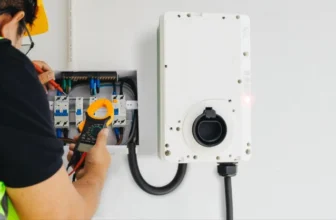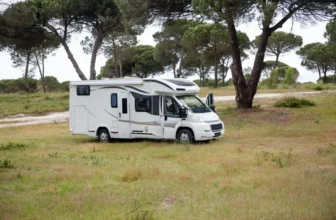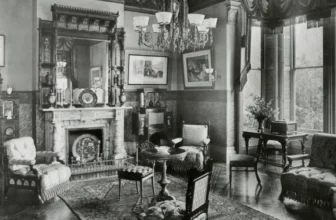Imagine that the grass in your backyard has grown a bit too high and is starting to look out of control. It needs a fresh trim, so you bring out your reliable lawn mower, turn the key in the ignition, but it fails to start. You might have an issue with your mower’s starter motor if the battery is fully charged or there’s fuel in the tank, but the machine still fails to start.
How Does A Starter Motor Work & What Does It Do?
The starter motor in a lawn mower is very similar to the one found in cars and trucks, albeit smaller. In layman’s terms, it is a small electric motor that cranks the engine to start the machine. As soon as you turn the key in the ignition, the engine starts cranking, as long as the airflow is sufficient to achieve combustion of fuel. The battery sources the power and engages the flywheel, following which the crankshaft starts spinning. The solenoid, which is an electromagnet that relays electricity through the system is engaged as well, as soon as the ignition is switched on. Once the engine is successfully turned on, the starter motor disconnects.
What Are the Symptoms of a Failing Starter Motor?
Lawn mower starter motors are simple devices, so they do have some signs to look out for to give you the heads-up when they stop functioning at their optimal level. Understanding these signs, and how to fix the issues behind them, could help you get more out of your starter motor, and avoid having to replace the motor prematurely. Additionally, it can save you time but helping you zero in on the key issue of why your lawn mower isn’t starting properly.
Some common symptoms of a failing starter motor are:
Buzzing Noises
If you hear a consistent buzzing noise after turning the ignition on, but the engine fails to crank, you might have a bad starter motor. This buzzing noise indicates that the motor is not actuating, despite an electricity flow to the starter. This often implies a lack of electrical power getting to the starter, and could be because of a poorly charged battery or corrosion on parts of the electrical connections within the system.
Loud Clicking
If you hear a loud series of clicks, or individual clicks when trying to start your lawn mower, it indicates a bad motor. Clicking noises imply that the starter is getting the required electricity to actuate, but the electric motor fails to respond and is malfunctioning. You may also hear a clicking sound if the starter solenoid doesn’t have ample power to move the gear or if the solenoid has gone extremely cold.
Grinding Sound
If there is a grinding sound when you try turning on your lawn mower, it is most likely implying a loose starter motor. Alternatively, it could also mean that there are
missing or worn teeth on the pinion gear or flywheel. As a result, the two gears aren’t able to function together and crank the engine properly.
Whirring Noise
The flywheel connects to the starter motor through a part known as the pinion gear. If these two parts fail to engage, the pinion gear will proceed to spin on its own and will result in an unpleasant whirring sound. When this happens, it generally indicates a failure in the starter solenoid.
What Causes Your Starter Motor to Go Bad?
There can be a variety of reasons why your starter motor has stopped functioning properly, and identifying said issue can go a long way in understanding whether it can be fixed, or if you need to replace the entire motor. Here are some of the common reasons that could be at play:
Defective Battery
Your battery could be defective if it is not holding charge, even after a sufficient recharge cycle, or if it isn’t generating enough voltage. It is quite easy to check the voltage of your battery with the help of a battery tester or multimeter. The battery of a starter motor should read 12 volts for it to be functioning fine – anything less than that means you have a defective battery, and it should be changed.
Dirty Leads
In simple terms, a lead is an electrical connection made of a metal pad and a wire. It is made to connect two locations electrically. In the case of a starter motor, the leads connect the positive and negative wires to the battery. If these leads aren’t clean, there will be poor electrical contact, hence causing the starter motor to malfunction. It is important to clean any dirt or corrosion from these leads to ensure your starter motor functions smoothly.

Spark Plug Issues
A spark plug is responsible for delivering electric current from the ignition system to the combustion chamber, to ignite the fuel–air mixture with an electric spark. To function smoothly, spark plugs need regular cleaning, and it is also good practice to regularly check for any wear or fouling on the wires connected to them. Carbonised or oily spark plugs could be one of the causes behind a faulty starter motor. If your spark plug is oily, the piston rings could be damaged as well, so just replacing spark plugs won’t solve the issue unless you replace your piston rings too.
Faulty Starter Solenoid
A starter solenoid is an electromagnet that engages the starter motor by relaying electrical charges to it from the battery. As such, if your starter solenoid is malfunctioning, your engine won’t work. A simple way to test your starter solenoid is to look for the terminal posts on it where the thick red wires connect. Touch a metal
shaft of a screwdriver to both terminals at the same time; if the engine starts, you have a faulty solenoid on your hands. On the other hand, if the engine fails to start, your solenoid is probably fine, and it’s the motor that has gone faulty.
How to Fix or Replace Your Starter Motor
While it is important to know and understand why your starter motor may be malfunctioning or showing performance issues, it is equally important to know how to fix those problems. Sometimes the fix could be as simple as swapping out the battery or solenoid, or cleaning the leads, but there will be times when the entire starter motor will have to be replaced. Though it is a simple process, it is necessary to know how to go about it to avoid further complications and to keep safe too.
A replacement starter motor is generally needed when your current starter motor is failing to engage the flywheel or if the gear stays stuck in the ‘up’ position. However, the most common reason for replacing a starter motor is that it has overheated and burned out, hence becoming damaged beyond repair. Here are some easy steps to help you replace your starter motor:
Step 1: Disconnect the Cables
The negative cable needs to be disconnected first, so you can avoid having a live positive wire. A live positive wire can cause sparking and a short circuit, which you want to avoid. Once the negative wire is safely disconnected, proceed to disconnect the positive wire.
Step 2: Apply Thread locker & Install Starter Motor
A thread locker is a liquid adhesive that secures nuts and bolts, and also prevents them from corrosion or damage through shock and vibration. Putting some adhesive on the bolts that hold the starter motor is a good idea before lining them up to the two holes underneath the starter motor. Make sure the bolts are installed evenly and tightened fairly. If the holes aren’t aligned properly, you can move the starter motor a bit to make sure the bolts are installed correctly.
Install Battery Cables
Before you proceed to install the cables, it is good practice to clean the posts and get rid of any corroded bolts. You can then clean it with a wire brush, and then add some dielectric grease to the posts if you want. This will protect your posts from corrosion and help them last longer. Once you are done cleaning the posts, install the battery cables on the starter and undo the nut. You can now try starting your lawn mower to see if everything checks out.
Buy Starter Motors & Spare Parts Online
Online stores have a substantial collection of starter motors and spare parts like starter solenoids, gears and ignition switches that you may need to fix your current
starter motor. They cater to lawn mowers of different makes and designs, hence making it easy for you to find exactly what you may be looking for








